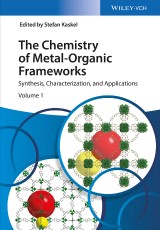Details

The Chemistry of Metal-Organic Frameworks
Synthesis, Characterization, and Applications1. Aufl.
|
291,99 € |
|
| Verlag: | Wiley-VCH |
| Format: | |
| Veröffentl.: | 16.06.2016 |
| ISBN/EAN: | 9783527693054 |
| Sprache: | englisch |
| Anzahl Seiten: | 904 |
DRM-geschütztes eBook, Sie benötigen z.B. Adobe Digital Editions und eine Adobe ID zum Lesen.
Beschreibungen
<p>Providing vital knowledge on the design and synthesis of specific metal-organic framework (MOF) classes as well as their properties, this ready reference summarizes the state of the art in chemistry. <br />Divided into four parts, the first begins with a basic introduction to typical cluster units or coordination geometries and provides examples of recent and advanced MOF structures and applications typical for the respective class. Part II covers recent progress in linker chemistries, while special MOF classes and morphology design are described in Part III. The fourth part deals with advanced characterization techniques, such as NMR, in situ studies, and modelling. A final unique feature is the inclusion of data sheets of commercially available MOFs in the appendix, enabling experts and newcomers to the field to select the appropriate MOF for a desired application. <br />A must-have reference for chemists, materials scientists, and engineers in academia and industry working in the field of catalysis, gas and water purification, energy storage, separation, and sensors.</p>
VOLUME 1<br> 1 Introduction<br> 2 Network Topology<br> PART I: MOF CHEMISTRY OF METALLIC CLUSTERS AND OTHER NODES<br> 3 Reticular Chemistry of Metal-Organic Frameworks Composed of Copper and Zinc Metal Oxide Secondary Building Units as Nodes<br> 4 Alkaline Earth Metal-Based Metal-Organic Frameworks: Synthesis, Properties, and Applications<br> 5 Synthesis, Structure, and Selected Properties of Aluminum-, Gallium-, and Indium-Based Metal-Organic Frameworks<br> 6 Group 4 Metals as Secondary Building Units: Ti, Zr, and Hf-based MOFs<br> 7 Iron and Groups V- and VI-based MOFs<br> 8 Platinum Group Metal-Organic Frameworks<br> 9 Group 3 Elements and Lanthanide Metals<br> PART II: FUNCTIONAL LINKERS<br> 10 Extended Linkers for Ultrahigh Surface Area Metal-Organic<br> 11 Porous Metal Azolate Frameworks<br> 12 Functional Linkers for Catalysis<br> 13 Chiral Linker Systems<br> 14 Functional Linkers for Electron-Conducting MOFs<br> 15 Linkers with Optical Functionality<br> <br> VOLUME 2<br> PART III: SPECIAL MOF CLASSES AND MORPHOLOGY DESIGN OF MOFS<br> 16 Nanoparticles<br> 17 SURMOFs: Liquid-Phase Epitaxy of Metal-Organic Frameworks on Surfaces<br> 18 Granulation and Shaping of Metal-Organic Frameworks<br> PART IV PROGRESS IN ADVANCED CHARACTERIZATION OF MOFS<br> 19 Adsorption Methodology<br> 20 Nuclear Magnetic Resonance of Metal-Organic Frameworks<br> 21 Electron Paramagnetic Resonance<br> 22 IR and Raman Spectroscopies Probing MOFs Structure, Defectivity, and Reactivity<br> 23 In Situ X-ray Diffraction and XAS Methods <br> 24 In Situ Studies of the Crystallization of Metal-Organic Frameworks<br> 25 Role of Molecular Simulations in the Field of MOFs <br> 26 Defects and Disorder in MOFs<br> Appendix A: MOF Suppliers<br> Appendix B: Datasheet<br> <br>
<p>"The scope of the book is ambitious and provides a comprehensive summary of the current field...As a whole the book is a good introduction for early stage researchers and a useful reference book for more established researchers within the MOF field." (<i>Johnson Matthey Technology Review</i> 21/04/2017)</p>
Stefan Kaskel is the Head of the Inorganic Chemistry Department at Technical University Dresden, Germany, and Head of the Business Unit Chemical Surface and Reaction Technology at Fraunhofer Institute for Material and Beam Technology (IWS) in Dresden. He obtained his Ph.D. from the University of Tubingen, Germany, in 1997. He then was a Feodor Lynen Fellow of the Alexander von Humboldt Foundation at Iowa State University, Ames (USA), working with John D. Corbett (1998 to 2000). He did his habilitation with Ferdi Schuth at the MPI fur Kohlenforschung in Mulheim a.d. Ruhr(Germany, 2000 - 2003) and was a group leader at this institute from 2002 to 2004. He was appointed full Professor of Inorganic Chemistry at the TU Dresden in June 2004. His research is focused on porous and nanostructured materials. He has coordinated the German MOF program from 2008 to 2014, with 36 German MOF groups involved and is Head of the DECHEMA task group on Metal-Organic Frameworks initiating the European MOF Conference Series (EuroMOF). He has authored more than 250 scientific publications and more than 40 patents.
Diese Produkte könnten Sie auch interessieren:

Mass Spectrometry of Inorganic and Organometallic Compounds
von: William Henderson, J. Scott McIndoe
Preis: 59,99 €

Neurodegenerative Diseases and Metal Ions, Volume 1
von: Astrid Sigel, Helmut Sigel, Roland K. O. Sigel
Preis: 228,99 €

Nickel and Its Surprising Impact in Nature, Volume 2
von: Astrid Sigel, Helmut Sigel, Roland K. O. Sigel
Preis: 356,99 €
-
-
© 2024 media control GmbH
Alle Preise enthalten die gesetzliche Mehrwertsteuer. - AGB
- Impressum
- Datenschutzerklärung
- Kontakt
- FAQ
- Mein Konto
- Home
- Erweiterte Suche
- Widerrufsrecht
- Reader-Software
- Desktop-Ansicht
- Gutschein-Code einlösen
- English